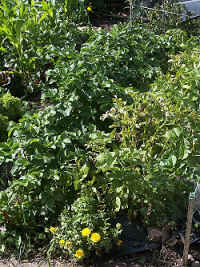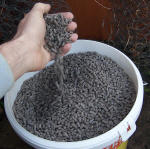

Chicken Manure - Green Garden Power
* Complete fertilizer and clay conditioner
But its proportionally higher nitrogen content makes it especially suitable for leafy crops like cabbage, salad crops, courgette, sweet corn, rhubarb, and celery as well as on spring lawns. I use it on all gross feeding plants including potatoes - see below.
Release Rate And ApplicationYou'd hardly notice the faint odor from dried chicken manure. But it's enough for you to know that some nitrogen is released immediately as ammonia. This is very soluble, so damp soil gets a small rush of nitrogen from the outset. Ensure the soil is sufficiently damp or watered when you apply it.Chicken manure has sufficient quantities of the other major nutrients P and K plus a full range of minor  nutrients too. These nutrients come out of complex organic matter as soil bacteria break it down. Get my manure here nutrients too. These nutrients come out of complex organic matter as soil bacteria break it down. Get my manure here
As my plants don't grow much in the cold season, a slow nutrient release at that time isn't a problem. There's no benefit in waste. see making liquid manure below. However, there's good reason to apply the fertilizer as early as possible in late winter and under soil warming fleece. When the ground warms a little soil bacteria release the plant nutrients over time. Use These Quantities For Base Fertilizer.
For Top Dressing FertilizerAlthough plant nutrients will go on being released for many weeks to feed your growing plants, it's better to spread out the total feed by applying top dressings later...
As A Soil ConditionerChicken manure contains plenty of calcium and has an alkaline ph 6.5 to 8. Despite the release of nitrogen containing ammonium which by itself acidifies soil, chicken manure may actually raise your soil ph. And ammonium tends to stick to clay soils. So all this is ideal for brassicas: cabbage, brussel sprouts... celery...Add to this organic matter and you have a superb soil conditioner capable of opening up clay soils. Only 150grams per square metre is needed for clays. Of course the organic matter helps to feed and bind light sandy soils too but in this situation I prefer to use bulk organic matter as well, e.g. garden compost. Note: Acid loving plants - ericas, rhodendrons, azaleas, camelia etc... as well as blueberries - all enjoy a low ph acid soil. Most fruit I grow prefer acid soils as do potatoes. You can expect chicken manure to raise the ph - perhaps making soil more alkaline for a short time - but quickly returning to its normal ph. So to some extent using manure with these plants depends on your pre-existing soil ph. Don't worry about chemistry. Manure is a major food source for growing big crops like potatoes. How to Use Fresh Poultry ManureFresh poultry manure is messy and needs careful handling - always wash afterwards. Never put it straight onto your garden.Easy To Use Poultry/Chicken ManureGet all the benefits of chicken manure from already composted - heat sterilised - dried chicken manure. Available as dried flakes, compressed pellets, or 6X which is a more concentrated form.
Make Liquid ManureHere's a way to feed your plants when the soil is not warm enough to release sufficient nutrients from dried manure - but I think this is rare.Calculate the area to be treated and the amount of manure that you would normally use. Put this amount into a sack and soak in water. Pellets will take time to dissolve. It is important that you don't apply the total dose all at once. Pour about one third of the liquid manure into a watering can to dilute it before watering onto soil around plants. Repeat after 2 weeks and 4 weeks using plenty of water. Liquid manure can be used to boost gross feeding plants when your soil is running short on supply. But do remember to add more nutrient rich garden compost.
The Are Many Organic Fertilizers
My Neighbour's Garden
^Top of page |



